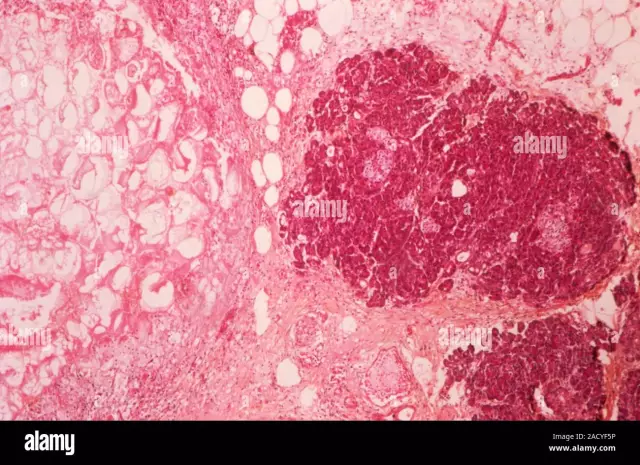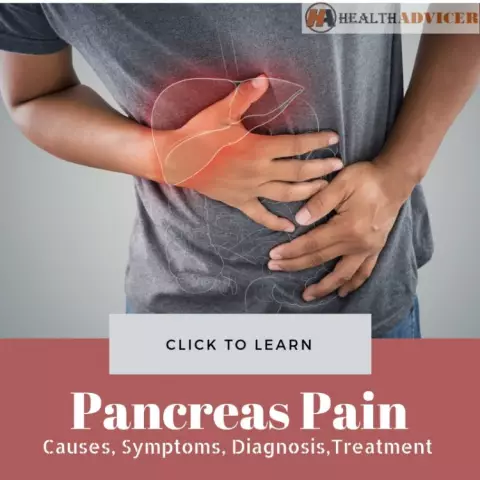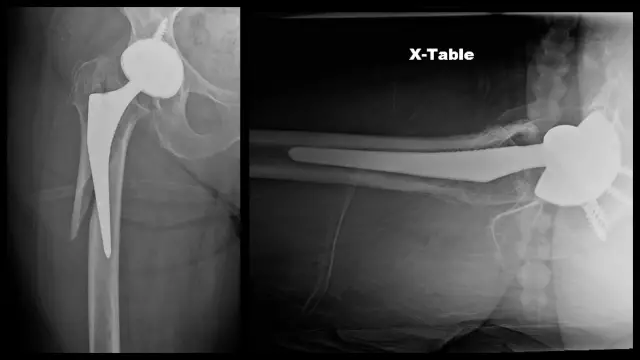- Author Rachel Wainwright [email protected].
- Public 2023-12-15 07:39.
- Last modified 2025-11-02 20:14.
Pancreatic necrosis

Pancreatic necrosis is a complication of such a serious illness as acute pancreatitis (inflammation of the pancreas). As a rule, mortality in pancreatic necrosis of the pancreas is 40-70%, and this is only on condition that patients begin to be treated in a timely manner using the most modern medical techniques.
For necrotizing pancreatitis, the dying off of any area or the entire pancreas is characteristic. This happens as a result of the action on the tissues of certain enzymes that the pancreas itself produces, in combination with an infectious process, peritonitis and other exacerbations.
Causes of pancreatic necrosis
According to statistics, about 70% of patients with pancreatic necrosis have consumed alcoholic beverages in excessive quantities for a long time. Another 30% of patients with pancreatic necrosis of the pancreas previously suffered from cholelithiasis.
Thus, the most common causes of pancreatic necrosis are:
- alcohol abuse;
- regular overeating, abuse of too fatty or fried foods;
- severe viral and infectious diseases;
- cholelithiasis;
- peptic ulcer and 12 duodenal ulcer;
- previous surgery or abdominal trauma.
Today, pancreatic necrosis is considered one of the most dangerous diseases of the abdominal cavity, in which not only the pancreas suffers, but also the work of other digestive organs is disrupted.
In the process of disease progression, the pancreas swells first, after which areas of necrotic tissue appear in it. If pancreatic necrosis is not diagnosed in time and does not proceed to immediate treatment, an abscess is often added to the process of pancreatic necrosis.
Stages of development of pancreatic necrosis
The development of this serious illness occurs in three stages:
- At the first stage of the development of pancreatic necrosis, toxemia occurs. At this stage, toxins of a bacterial nature appear in the patient's blood. Moreover, the presence of microbes in the blood is not at all necessary, which these same bacteria produce.
- An abscess is formed in the pancreas at the second stage of pancreatic necrosis. Often, an abscess is formed in nearby organs.
- At the third stage, purulent changes occur in the tissues of the pancreas, as well as in the retroperitoneal tissue.
Pancreatic necrosis symptoms
The most important symptom of pancreatic necrosis is acute pain in the left hypochondrium, which radiates to the shoulder, side and back, and sometimes to the region of the heart. The pain is constant, but sometimes it can subside a little, especially if you take a horizontal position and press your knees against your stomach. The nature of the pain largely depends on the course of pancreatic necrosis, its causes and form:
- 6% of patients characterize pain as moderate;
- 10% are in a state of collapse due to severe pain;
- 40% of patients experience acute pain;
- 44% described the pain as very severe, almost unbearable.
Another integral symptom of pancreatic necrosis of the pancreas is vomiting, which, by the way, does not bring relief to the patient. As a result of constant vomiting, the patient dehydrates.
Since an increase in the concentration of vasoactive components is observed in the blood plasma of a patient with pancreatic necrosis, another indirect symptom is prolonged facial redness. But when the patient enters a state of collapse, his skin, on the contrary, turns pale.
With this disease, the level of elastase in the blood rises, which in excessive quantities tends to destroy blood vessels, which contributes to the occurrence of bleeding in the digestive tract. The consequence of the destruction of blood vessels and necrotic phenomena in the pancreas are spots on the buttocks of a blue-violet color. They can also be seen on the anterior abdominal wall, sides and around the navel.

These are not all the symptoms of pancreatic necrosis. For example, when examining a patient in the pleural, abdominal cavity, as well as in the pericardial cavity, an effusion can be found.
Treatment of pancreatic necrosis
The prognosis of this disease largely depends on the adequate and timely treatment of pancreatic necrosis, as well as on the degree of damage to the pancreas. Early diagnosis of the disease is of great importance in successful treatment. Mostly pancreatic necrosis of the pancreas in patients can be diagnosed at the first stage.
As a treatment for pancreatic necrosis at the first stage, medications are used, with the help of which the work of the pancreas is blocked. Operation for pancreatic necrosis at the first stage of development is not advisable, since it is impossible to clearly identify which part of the pancreas has undergone necrosis.
In order to avoid various purulent processes, in addition to drugs that block the work of the pancreas, the patient is prescribed antiseptic and antibacterial drugs, as well as immunostimulants.
With timely and correct treatment of pancreatic necrosis, its progression can be stopped at an early stage without the development of any serious complications. However, inflammation develops more often, and the pancreas destroys itself. Then it is advisable to carry out an operation for pancreatic necrosis, which involves the removal of the destroyed tissue of the pancreas. The operation for pancreatic necrosis is very difficult for the patient and for the surgeon is also associated with a certain risk, therefore, they resort to it only in extreme cases. Often there is an intoxication of the body, when many organs simply refuse to work.
Surviving with pancreatic necrosis is less than half of the patients. If, nevertheless, someone got a lucky ticket, then throughout the rest of his life this person needs to be very careful about his health. All excesses should be taboo for life. It is necessary to eat only stewed or steamed dishes in fractional portions 5-6 times a day. All food should be at a neutral temperature - too hot or cold food irritates the stomach and helps to activate the pancreas. Fatty foods are also prohibited, as it takes a long time to digest and unnecessarily strains the pancreas. It is forbidden to eat anything salty, sweet and smoked, as such food contributes to inflammatory processes.
You can eat dried bread, boiled vegetables, dairy products, lean meat, light broths and cereals on the water. You should forever forget about fresh vegetables and fruits, mayonnaise, spices, chocolate, soft bread, carbonated drinks, milk, various canned food and alcohol.
YouTube video related to the article:
The information is generalized and provided for informational purposes only. At the first sign of illness, see your doctor. Self-medication is hazardous to health!






